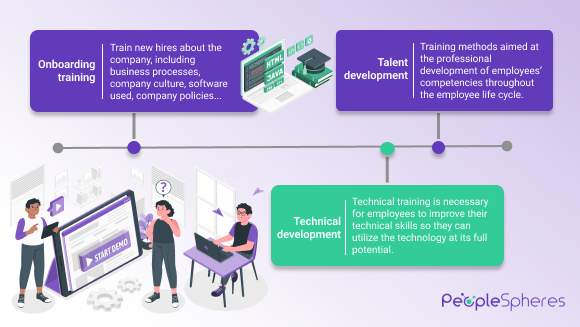-640x380.jpg)
Employee training refers to activities or programs meant to educate employees. It covers any time of training, from training programs for soft skills, vocational training, mentoring, and training for general employee development. Having effective training is necessary for many reasons, such as enhancing employee performance, increasing workplace productivity, and higher employee retention.
Related articles:
The Ultimate Guide for People Analytics
What You Need to Know to Create an Effective Onboarding Process
Employee Training Start and End
Employee training is one of the main responsibilities of the human resources department. Although most companies recognize the importance of training and development for new employees, they fail to acknowledge the significance of continuous corporate training throughout the entire employee life cycle. Since employee performance is directly related to business performance, every HR management department should implement training for the different stages of the employee life cycle.
Onboarding Training
All employees will experience employee training for the first time during their onboarding. This type of training is called onboarding training. Onboarding training is meant to train new hires about the company that they just joined. This includes anything from business processes, company culture, software used, company policies, and more. You can build a knowledge base for smoother onboarding process as this will bring together all these resources in one place. The onboarding training is a part of the new employee orientation to learn more about the business, both technical and cultural.
Talent Development
After the onboarding training, it is important to not stop the training development. There are other types of training methods aimed at the professional development of employees’ competencies throughout their employee life cycle. Talent development training increases employee loyalty, attracts new employees, and capitalizes on the employee experience.
Technical Development
As companies are adopting more technology at the workplace, technical training is becoming a bigger part of employee training. Technical training is necessary for employees to improve their technical skills in the workplace and the human resource department should provide training opportunities for all employees when adapting to new technology, no matter where they are in their employee life cycle. If you have properly trained staff, regardless of if they are a new employee or if they have been employed for 20+ years, they will utilize all technology deployed by the company at its fullest potential.

Types of Training
There are different types of employee training programs. Depending on your business needs and the development of your employees, different types of training may be appropriate for your company. Below, we list the most common ones:
New Job Training
New job training aims to train employees on a new job. This includes both new hire and an employee that has changed job within the organization. The goal is to train the employee on the new role and everything that it entails.
Coaching and Mentoring Employees
Coaching and mentoring are important elements of employee training. As a part of employee learning and development, employees need leaders to motivate them through coaching and mentoring. This is certainly true for new employees and interns. As interns join companies as a part of their education, it is a manager’s duty to train and guide interns. This can be done by supervising, developing their operational skills, teaching them and making them interested in the company, and by communicating clearly.
Soft Skill Training
Soft skills training aims to train interpersonal attributes that are valuable in the workplace. Soft skills development can be trained both through coaching and mentoring, but also through training programs and workshops hosted by the HR team. Soft skills that are valuable in a workplace and can be trained in development programs or by supervisors include:
- Oral and written communication skills
- Time management
- Leadership skills
- Critical thinking and problem-solving
- Teamwork and collaboration skills
- Work Ethic
- Emotional intelligence
- And more
Besides the fact that soft skills are valuable in the workplace, interpersonal skills training can help individuals to improve on a personal level. The training can be useful in employees’ social life outside of work, such as the development of social competencies and health-related behavior. It can also have a positive impact on an individual’s physiological state such as improved attitude, motivation, and self-confidence.
Upskilling
Upskilling is the practice of teaching current employees new and improved skills that match the changing demands of their job roles. This approach focuses on continuous learning and development to ensure that staff members can adapt to technological advancements and shifts in the market. It’s a proactive strategy to maintain a competitive workforce by enhancing their capabilities, rather than hiring new employees.
It also involves assessing the existing skills of employees and identifying gaps where additional training is needed. By providing targeted training programs, workshops, or courses, companies help employees grow professionally and stay relevant in their fields. This not only benefits the employees by broadening their skill sets but also boosts the overall productivity and innovation within the organization.
Job Shadowing
Job shadowing is an experiential learning opportunity where an individual, often a student or someone exploring a new career path, spends time observing a professional at work. This hands-on experience provides insight into the daily activities, responsibilities, and challenges of a specific role or industry.
It’s particularly useful because it allows the observer to gain a realistic understanding of a job’s demands and the workplace environment, which can be invaluable when making informed career choices or educational decisions. This direct exposure also facilitates networking and builds relationships with professionals in the field.
Feedback
Employee feedback serves as a foundation for employee training and development. For employees to improve their knowledge and skills, it is essential that they get feedback on their performance at the workplace. Feedback appointments should be a pleasant occasion for both manager and employee, and it is important for supervisors to encourage their employees and provide clear and concise guidelines for improvement. This can be done through a development plan that establishes a clear path forward for the employee.
How to Strategize Your Employee Training
Employee training should be strategized to ensure optimized results. The strategy should guide how to achieve educational goals within the company. The first part of developing a training strategy is to identify skill gaps within the organization. Once identified, assess resources, and prioritize the training needs based on resources and available budget. At this point, it is a good idea to draft a training plan, which should include all steps of the training. When sketching the training plan, ask yourself questions like:
- Are you going to hire training leaders, or can you assign this role to someone within the organization?
- What employees will be trained?
- What does the training timeline look like? Are there going to be any ongoing programs through employee training software, seminars, or workshops?
After the training has been implemented, monitor employee performance and development and make adjustments to your training strategy accordingly.
How Employee Training is Changing Over the Years
As technology is developing, training trends are also constantly changing. Changes include personalized training for different demographics, shifts in mindset, and technology-based training. Below, we go through them all:
Differences between Gen Z and Millennials
Managers need to acknowledge that new opinions, work ethics, and beliefs are entering the workplace with Generation Z. Just like Millennials and Baby Boomers are differentiated, so are Generation Z. As Generation Z has grown up in a technological age, they are known to have greater technical skills than other generations. They are also known to have shorter attention spans and quickly process and filter information.
All these things need to be taken into consideration when deploying employee training for different generations. For example, older generations might require technical training that Generation Z does not need. However, when training Generation Z, you might want to use innovative training methods, such as interactive training, to ensure that they do not lose attention from the training.
Shift in Mindset
The employee training process is shifting from occasional and guided training to constant and diverse training. Training for employees has gone from passive training lectures directed by a leader to more hands-on training that include interactive courses and plans where employees control their own development more. As more employers are looking for new ways to train employees, new methods that are combining mobile capabilities with embedded training with gamification and incentives have proved to be specifically useful.
Companies are also shifting from one-time training to a culture of continuous learning, recognizing it as key to both employee and business growth. Instead of treating training as a checkbox, they now invest in ongoing development, offering personalized learning paths and digital tools. This approach encourages employees to take charge of their growth, fostering innovation and engagement while boosting job satisfaction and retention.
Technology-Based Training
As technology is becoming prominent in most areas within HR management, it is becoming a bigger part of employee training as well. Technology-based training uses specialized technology when training employees. Modern online training uses interactive training tools to activate the trainee. With an AI video generator, organizations can produce high-quality, customized video content that aligns with their training goals. Technology-based training can take form in many ways, including eLearning, webinars, instructional videos, VR training, and more.
One innovative way to streamline employee training materials and enhance accessibility is to create a personalized QR code for employees. These QR codes can link to training modules, instructional videos, or company policies, allowing employees to access relevant information quickly and efficiently with a simple QR code scan. Many progressive companies are utilizing Otix to generate customized QR codes that seamlessly integrate with their existing e-learning platforms.
Utilization of Software to Reinforce Employee Training
It is recommended to utilize software to reinforce employee training. The software can be used to automate and make employee training programs more efficient. PeopleSpheres consolidates all your HR apps on one platform, which allows you to gather all your HR training in one place.
With PeopleSpheres, your employee experience will improve as employees will not have to navigate between different user interfaces and programs during their training programs. The management system can automate training sessions such as during onboarding, to take away HR workload from managers. With the help of software, supervisors can evaluate their employees through reports and online feedback.
Conclusion
Employee training should be implemented at all stages of the employee life cycle. Proper training programs will lead to an increase in employee productivity and experience, along with loyalty. There are different ways to adapt training of employees, such as feedback, soft skill trainings, onboarding training, and mentoring/coaching. Decide which training program you want to deploy based on your business needs and resources. To assure an efficient training program, create a training strategy and plan that covers all the details. The best practice is done with the help of management tools, that offer software that automates and streamlines the training process. The software also makes it easier to track and monitor employee performance, a crucial step when adapting your training strategy.



 (1)-640x380.jpg)
-640x380.jpg)
-666x380.jpg)